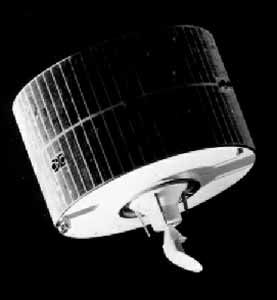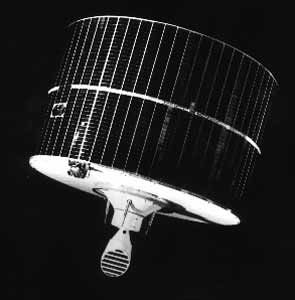
Home - Search - Browse - Alphabetic Index: 0- 1- 2- 3- 4- 5- 6- 7- 8- 9
A- B- C- D- E- F- G- H- I- J- K- L- M- N- O- P- Q- R- S- T- U- V- W- X- Y- Z
NATO 1
 NATO 1 Credit: Manufacturer Image |
AKA: NATO. Status: Operational 1969. First Launch: 1969-11-22. Last Launch: 1971-02-03. Number: 4 . Gross mass: 243 kg (535 lb).
More at: NATO 1.
Family: Communications, Geosynchronous orbit, Military communications sat. Country: UK. Engines: Star 17A. Spacecraft: Skynet. Launch Vehicles: Thor, Delta, Thor Delta M. Launch Sites: Cape Canaveral, Cape Canaveral LC17A. Agency: MoD, NATO. Bibliography: 2, 279, 6, 12870, 12871.
 | Skynet 1A Credit: Manufacturer Image |
1967 Nov - .
- Communications satellite system for NATO. - .
Spacecraft Bus: Skynet.
Spacecraft: NATO 1.
The Department of Defense directed SAMSO to procure a communications satellite system for the North Atlantic Treaty Organization (NATO). Essentially, the NATO system was a duplication of the British Skynet communications satellite system developed and built by Philco-Ford.
1968 Apr - .
- Two-satellite communications system for NATO. - .
Spacecraft Bus: Skynet.
Spacecraft: NATO 1.
After completion of an agreement between the Defense Department and the North Atlantic Treaty Organization (NATO), SAMSO initiated procurement of a two-satellite communications system for NATO. Philco-Ford Corporation was selected to build the two satellites that would be nearly identical to those produced for the United Kingdom's Skynet program.
1969 November 22 - . 00:37 GMT - . Launch Site: Cape Canaveral. Launch Complex: Cape Canaveral LC17A. LV Family: Thor. Launch Vehicle: Thor Delta M.
- Skynet 1A - .
Mass: 243 kg (535 lb). Nation: UK.
Agency: MoD.
Program: Skynet.
Class: Communications.
Type: Military communications satellite. Spacecraft Bus: Skynet.
Spacecraft: NATO 1.
Completed Operations Date: 1980-01-01 . USAF Sat Cat: 4250 . COSPAR: 1969-101A. Apogee: 35,894 km (22,303 mi). Perigee: 35,682 km (22,171 mi). Inclination: 13.90 deg. Period: 1,436.20 min.
Skynet IA, the first of two Skynet military communications satellite built for the United Kingdom by the Philco-Ford Corporation, was launched from Cape Canaveral aboard a NASA Long Tank Thrust Augmented Thor/Delta (DSV-3L). The satellite was turned over to the United Kingdom on 30 January 1970, providing the United Kingdom with its first operational military communications satellite system. The Skynet satellites were designed to be usable with the Initial Defense Satellite Communication System (IDSCS) satellites of the United States. Over Indian Ocean. Military communications. Previously registered by the United States in A/AC.105/INF.220: 1969-101A, orbital data 276 x 36716 km x 28.0 deg, category C. Positioned in geosynchronous orbit over the Indian Ocean at 41 deg E in 1969-1972?; ??? 1972-1977; over the Americas at 100-110 deg W in 1977-1998 As of 26 August 2001 located at 104.51 deg W drifting at 0.015 deg W per day. As of 2007 Mar 9 located at 106.94W drifting at 0.015W degrees per day.
1970 March 20 - . 23:52 GMT - . Launch Site: Cape Canaveral. Launch Complex: Cape Canaveral LC17A. LV Family: Thor. Launch Vehicle: Thor Delta M.
- NATO 1 - .
Payload: NATO IIA. Mass: 243 kg (535 lb). Nation: NATO.
Agency: NATO.
Program: NATO.
Class: Communications.
Type: Military communications satellite. Spacecraft Bus: Skynet.
Spacecraft: NATO 1.
Completed Operations Date: 1977-01-01 . USAF Sat Cat: 4353 . COSPAR: 1970-021A. Apogee: 35,801 km (22,245 mi). Perigee: 35,768 km (22,225 mi). Inclination: 13.40 deg. Period: 1,436.00 min.
The first of two communications satellites built for the North Atlantic Treaty Organization (NATO) by the Philco-Ford Corporation under a SAMSO contract was launched from Cape Canaveral aboard a NASA Long Tank Thrust Augmented Thor/ Delta booster. Inserted into synchronous orbit on 23 March, the satellite was turned over to the Supreme Headquarters Allied Forces Europe (SHAFE) on 19 May. Spacecraft engaged in practical applications and uses of space technology such as weather or communication (US Cat C). Positioned in geosynchronous orbit over the Atlantic Ocean at 18 deg W in 1970-1972; over the Americas at 100-110 deg W in 1977-1998 As of 3 September 2001 located at 101.97 deg W drifting at 0.023 deg E per day. As of 2007 Mar 9 located at 100.55W drifting at 0.016W degrees per day.
1970 August 19 - . 12:11 GMT - . Launch Site: Cape Canaveral. Launch Complex: Cape Canaveral LC17A. LV Family: Thor. Launch Vehicle: Thor Delta M.
- Skynet 1B - .
Mass: 243 kg (535 lb). Nation: UK.
Agency: MoD.
Program: Skynet.
Class: Communications.
Type: Military communications satellite. Spacecraft Bus: Skynet.
Spacecraft: NATO 1.
USAF Sat Cat: 4493 . COSPAR: 1970-062A. Apogee: 37,460 km (23,270 mi). Perigee: 278 km (172 mi). Inclination: 25.90 deg. Period: 665.40 min.
The second of two British Skynet I communication satellites (Skynet B) was launched from Cape Canaveral for U.S. Air Force and United Kingdom aboard a NASA Long Tank Thrust Augmented Thor/ Delta (DSV-3M) space booster. The spacecraft was placed in a transfer orbit prior to firing of the apogee kick motor that was to put it into a synchronous orbit over Kenya. Contact with Skynet B was lost during the firing of the apogee kick motor on 22 August and was not regained. The Skynet I satellites were part of the Initial Defense Satellite Communication System (TDSCS) program which was managed for the United Kingdom by SAMSO, with NASA providing launch vehicles and services. AKM failure left in unusable orbit. Spacecraft engaged in practical applications and uses of space technology such as weather or communication (US Cat C).
1971 February 3 - . 01:41 GMT - . Launch Site: Cape Canaveral. Launch Complex: Cape Canaveral LC17A. LV Family: Thor. Launch Vehicle: Thor Delta M.
- NATO 2 - .
Payload: NATO IIB. Mass: 243 kg (535 lb). Nation: NATO.
Agency: NATO.
Program: NATO.
Class: Communications.
Type: Military communications satellite. Spacecraft Bus: Skynet.
Spacecraft: NATO 1.
Completed Operations Date: 1984-06-01 . USAF Sat Cat: 4902 . COSPAR: 1971-009A. Apogee: 35,802 km (22,246 mi). Perigee: 35,772 km (22,227 mi). Inclination: 13.90 deg. Period: 1,436.10 min.
The second NATO military communications satellite (NATO IIB) was launched by NASA aboard a Thrust Augmented Thor/Delta booster. Developed for NATO under SAMSO program management, the spacecraft was first placed in a transfer orbit and then moved into an acceptable synchronous orbit on 4 February. Although numerous difficulties were experienced prior to launch, the satellite achieved its stationary orbit and has performed successfully since then. Spacecraft engaged in practical applications and uses of space technology such as weather or communication (US Cat C). Positioned in geosynchronous orbit over the Atlantic Ocean at 26 deg W in 1971-1975?; over the Americas at 105 deg W in 1976-1983; over the Americas at 110 deg W in 1983; over the Americas at 105 deg W in 1983-1998 As of 5 September 2001 located at 104.88 deg W drifting at 0.004 deg W per day. As of 2007 Mar 9 located at 105.24W drifting at 0.007W degrees per day.
1976 August 19 - .
- NATO satellite IIB fails. - . Spacecraft Bus: Skynet. Spacecraft: NATO 1. All user access on NATO satellite IIB was terminated because of the failure of the last traveling wavetube amplifier. The satellite was moved to 107 degrees West longitude on 31 October 1976..
Back to top of page
Home - Search - Browse - Alphabetic Index: 0- 1- 2- 3- 4- 5- 6- 7- 8- 9
A- B- C- D- E- F- G- H- I- J- K- L- M- N- O- P- Q- R- S- T- U- V- W- X- Y- Z
© 1997-2019 Mark Wade - Contact
© / Conditions for Use